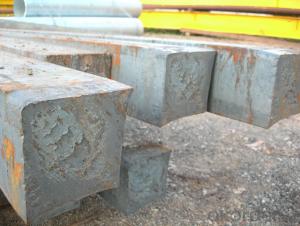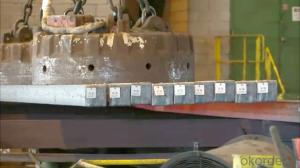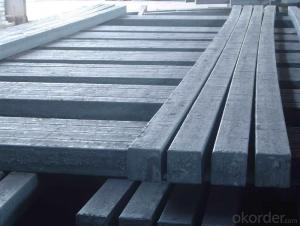Prime square alloy steel billet 140mm Q235
- Loading Port:
- Shanghai
- Payment Terms:
- TT OR LC
- Min Order Qty:
- 100 m.t.
- Supply Capability:
- 10000 m.t./month
OKorder Service Pledge
OKorder Financial Service
You Might Also Like
Structure of Prime square alloy steel billet 140mm Q235

Description of Prime square alloy steel billet 140mm Q235
1) Excellent corrosion resistance: The zinc layer provides a good protection of Pre-painted Galvanizeed Steel Sheet.
2) High heat resistance: The reflective surface of the material aids in efficiently reflecting the sunlight away and in turn reducing the amount of heat transmitted. The thermal reflectivity converts into energy savings.
3) Aesthetics: Pre-Painted Galvanized steel sheet is available in plethora of patterns and multiple sizes as per the requirements that given by our customers.
4) Versatility: can be used in the various areas.

Main Feature of Prime square alloy steel billet 140mm Q235
Uncoated CR steel sheet
With the features of in line with the international highest standards in demension and shape, excellent surface finish and properties, the products are mainly used in home appliance and automobile industries.
Galvanized steel sheet(include HDG and EG)
With the features of good corrosion resistance, the products are mainly used in automobile, home appliance, electronics, building and machinery manufacture industries, etc.
Precoated steel sheet
With the features of enviromental protection and good processablility, long lasting surface durability, rich in colors, the products are maily used in building, home appliance and furniture industries, etc.
Applications of Prime square alloy steel billet 140mm Q235
1) Excellent corrosion resistance: The zinc layer provides a good protection of Pre-painted Galvanizeed Steel Sheet.
2) High heat resistance: The reflective surface of the material aids in efficiently reflecting the sunlight away and in turn reducing the amount of heat transmitted. The thermal reflectivity converts into energy savings.
3) Aesthetics: Pre-Painted Galvanized steel sheet is available in plethora of patterns and multiple sizes as per the requirements that given by our customers.
4) Versatility: can be used in the various areas.

Specifications of Prime square alloy steel billet 140mm Q235
Product | Billet |
Material Grade | SGCC / SGCH / DX51D+AZ, etc |
Thickness | 0.6-3.0mm |
Width | 500-1500mm |
Tolerance | Thickness: +/-0.02mm , Width:+/-2mm |
Zinc-coating | Z30-150g/m2 |
Technique | Raw material: Hot rolled steel coil --> Cold rolled_>hot dipped galvalume |
Surface | Dried, Chromated, Unoiled |
Spangle | Regular spangle , small spangle, zero spangle |
ID | 508MM 610MM |
Coil weight | 1-25MT |
Export package | Cardboard inner sleeves, Waterproof paper, galvanized steel covered and steel strip packed |
FAQ of Prime square alloy steel billet 140mm Q235
We have organized several common questions for our clients,may help you sincerely:
1. How Can I Visit There?
Our company is located in Tianjin City, China, near Beijing. You can fly to Tianjin Airport Directly. All our clients, from home or aboard, are warmly welcome to visit us!
2. How Can I Get Some Sample?
We are honored to offer you sample.
3. Why choose CNBM?
we always fix steel produce in container well to make it safe arrive at destination port
we always provide best and professional forward service for our buyer
we always apply 14days free detention for our buyers container in destination
we provide one set After-sales service for our buyer
we provide China inland steel market price report
we help our buyer become number one in local market .
- Q:What is the average density of a steel billet?
- The average density of a steel billet is typically around 7.8 grams per cubic centimeter.
- Q:What is the typical weight of a steel billet?
- The typical weight of a steel billet can vary depending on the specific dimensions and requirements, but it is commonly found to range between 1,000 to 5,000 kilograms or 2,205 to 11,023 pounds.
- Q:What are the different types of steel billet extrusion processes?
- There are several different types of steel billet extrusion processes, including direct extrusion, indirect extrusion, and hydrostatic extrusion.
- Q:How are steel billets used in the production of mining equipment?
- Steel billets are an essential component in the production of mining equipment due to their strength, durability, and versatility. These billets are typically made from molten steel that is poured into a mold to form a solid rectangular shape. The resulting billets are then used as raw material in the manufacturing process of mining equipment. Mining equipment, such as excavators, bulldozers, and crushers, require robust and reliable components to withstand the harsh conditions and heavy loads experienced in mining operations. Steel billets provide the necessary structural integrity and toughness to ensure the equipment can operate efficiently and safely. Once the steel billets are obtained, they are further processed through various techniques, such as forging, machining, and welding, to transform them into specific parts and components. For example, billets can be hot or cold forged to create heavy-duty gears, shafts, and axles, which are crucial for the functioning of mining equipment. Additionally, steel billets can be machined to precise dimensions and specifications, allowing the production of custom-made components that fit seamlessly into the mining equipment. This machining process involves cutting, drilling, and milling to create parts like buckets, cutting edges, and chassis. Furthermore, steel billets can undergo welding processes to join different parts together and create complex structures. Welding ensures the integrity and strength of the equipment, as it provides a secure bond between the billets and other components. This is particularly important in the construction of mining equipment, where safety and reliability are paramount. Overall, steel billets play a vital role in the production of mining equipment by providing the necessary raw material for the manufacturing process. Their strength, durability, and versatility make them ideal for creating robust and reliable components that can withstand the demanding conditions encountered in mining operations.
- Q:What are the different testing methods used for steel billets?
- To ensure the quality and suitability of steel billets for various applications, multiple testing methods are employed. These methods encompass: 1. Visual Inspection: The most straightforward and widely used technique involves visually examining the billets for visible defects like cracks, surface irregularities, or foreign materials. 2. Dimensional Inspection: To meet specific dimensional requirements, the length, width, and height of the billets are measured using calibrated tools, ensuring they adhere to the specified tolerances. 3. Ultrasonic Testing: Detecting internal defects, this non-destructive method employs high-frequency sound waves. By transmitting sound waves into the material and analyzing the reflected waves, flaws or inconsistencies can be identified. 4. Magnetic Particle Inspection: Utilized primarily to detect surface and near-surface defects, this method applies a magnetic field to the billet, followed by the application of a magnetic particle solution. Any cracks or defects cause the particles to accumulate, creating visible indications. 5. Eddy Current Testing: This technique involves passing an alternating current through a probe, generating an electromagnetic field. Placing the probe near the billet's surface allows the detection of defects through changes in electrical conductivity or magnetic permeability, which induce eddy currents. 6. Chemical Analysis: The composition of steel billets, including the percentage of elements like carbon, manganese, and silicon, is determined through chemical analysis. This ensures compliance with the required chemical composition for their intended use. 7. Tensile Testing: By subjecting a sample taken from the billet to tension until it fractures, tensile testing measures mechanical properties such as strength, ductility, and elasticity. The applied force and resulting elongation or deformation provide insights into the billet's mechanical characteristics. These testing methods comprehensively assess steel billets for defects, dimensional accuracy, and material properties. By ensuring adherence to industry standards and meeting specific application requirements, the suitability and quality of the billets are guaranteed.
- Q:What are the different surface treatments for corrosion resistance in steel billets?
- There are several surface treatments available for corrosion resistance in steel billets, including hot-dip galvanizing, electroplating, and mechanical plating. Hot-dip galvanizing involves immersing the steel billets in molten zinc, creating a protective layer that prevents corrosion. Electroplating uses an electric current to deposit a layer of metal, such as zinc or chromium, onto the surface of the billets. Mechanical plating involves tumbling the billets with metal powder, typically zinc, in a rotating drum to create a protective coating. Each of these treatments provides varying degrees of corrosion resistance and can be chosen based on specific requirements and budget constraints.
- Q:How do steel billets contribute to the defense industry?
- Steel billets play a crucial role in the defense industry by providing the necessary raw material for manufacturing various defense equipment and vehicles. These billets are essentially semi-finished steel products that are used as a starting point for further processing and shaping into specific components. One of the primary applications of steel billets in the defense industry is in the production of armored vehicles. These vehicles require a high level of protection to withstand potential threats such as ballistic attacks or explosive devices. Steel billets are used to manufacture the armor plates and panels that provide the necessary strength and resilience to these vehicles. Additionally, steel billets are utilized in the production of various weapon systems, including firearms, artillery guns, and missiles. The strength and durability of steel make it an ideal material for constructing the barrels, chambers, and other critical components of these weapons. The ability of steel to withstand high temperatures and pressures is crucial for ensuring the reliable and efficient performance of these defense systems. Furthermore, steel billets are also used in the manufacturing of naval vessels, submarines, and aircraft carriers. These military ships and submarines require steel components that can withstand the harsh marine environment, including corrosion, impact, and extreme temperatures. Steel billets are used to produce these components, ensuring the structural integrity and longevity of these vessels. In summary, steel billets are indispensable to the defense industry as they provide the essential raw material for manufacturing a wide range of defense equipment. Their strength, durability, and versatility make them ideal for producing armored vehicles, weapon systems, naval vessels, and other defense-related components. By contributing to the production of these crucial assets, steel billets play a vital role in strengthening national defense capabilities.
- Q:How are steel billets used in the production of hydraulic components?
- Steel billets are used in the production of hydraulic components as they serve as the raw material to create various parts, such as cylinders, pistons, valves, and fittings. These billets are heated and shaped through processes like forging, machining, and casting to form the required hydraulic components with the desired strength, durability, and dimensional accuracy.
- Q:How do steel billets contribute to sustainable construction?
- Steel billets contribute to sustainable construction in several ways. Firstly, steel is a highly durable and long-lasting material, which means that structures made from steel billets have a longer lifespan and require less maintenance and repair over time. This reduces the need for frequent reconstruction and minimizes waste generation. Secondly, steel is a recyclable material, and steel billets can be easily melted down and reused in the production of new steel products without losing their quality. This reduces the demand for raw materials and energy consumption, reducing the environmental impact of construction. Furthermore, steel is known for its strength and load-bearing capacity, allowing for the design of lighter and more efficient structures. This not only reduces the amount of steel required in construction but also decreases the overall weight of the building, which can lead to energy savings during transportation and construction. Lastly, steel is resistant to pests, such as termites, and is not susceptible to rot or decay. This eliminates the need for chemical treatments and preservatives, making it a safer and more sustainable choice for construction. Overall, steel billets contribute to sustainable construction by promoting durability, recyclability, energy efficiency, and reduced environmental impact.
- Q:What is the difference between continuous casting billet and cast billet?
- but with high-grade continuous casting line (full protection casting, electromagnetic stirring, liquid stopper control) compared both have a big difference in the crystal, oxidation, surface quality.
1. Manufacturer Overview |
|
|---|---|
| Location | |
| Year Established | |
| Annual Output Value | |
| Main Markets | |
| Company Certifications | |
2. Manufacturer Certificates |
|
|---|---|
| a) Certification Name | |
| Range | |
| Reference | |
| Validity Period | |
3. Manufacturer Capability |
|
|---|---|
| a)Trade Capacity | |
| Nearest Port | |
| Export Percentage | |
| No.of Employees in Trade Department | |
| Language Spoken: | |
| b)Factory Information | |
| Factory Size: | |
| No. of Production Lines | |
| Contract Manufacturing | |
| Product Price Range | |
Send your message to us
Prime square alloy steel billet 140mm Q235
- Loading Port:
- Shanghai
- Payment Terms:
- TT OR LC
- Min Order Qty:
- 100 m.t.
- Supply Capability:
- 10000 m.t./month
OKorder Service Pledge
OKorder Financial Service
Similar products
New products
Hot products
Related keywords

































